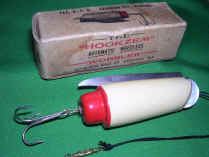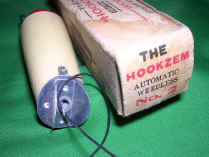|
Jim Harvey, Lakeville, Connecticut Jim Harvey was a well-known fly tackle manufacturer who also held numerous patents related to the firearms industry. His resin-coated lures are very distinct. This Weighted Shiner and black box date to the late 1930s. |
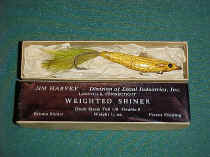 |
Haas Liv-Minno, Oklahoma Dr. Harry Haas of Sapulpa, Okla., patented this jointed, wooden bait July 16, 1935. This rare picture box is the earliest. Later lures were made of a composition material. The receipt inside shows the lure was purchased in June 1935 from a hardware store. The hand-crafted wooden lure is wonderful; it has 32 separate parts, and hand-cut gills! |
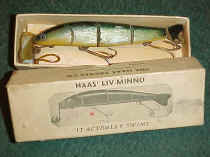 |
Haas Liv-Minno, Sapulpa, Okla. This is a later version of the Haas Liv Minno pictured above. Dr. Haas grew weary of the wooden models after a year or two and made these composition material baits in the late 1930s. They were brittle and breakable, but attractively painted in a lifelike finish. This box is simpler. This black scale Haas Liv-Minno was acquired from a visitor to this website. |
 |
Haas Liv-Minno glass eye Oklahoma Here is the earliest Haas Live Minnow I have seen: a wonderfully painted Rainbow color with glass eyes. Even the paint on the metal tail fin is blended like a rainbow trout. The early picture box it was found in is marked "patent pending" on the endflap, placing it between the lure's introduction in 1933 and the patent, issued July 16, 1935. |
|
|
Halik Frog, Moose Lake, Minnesota This mechanical plastic lure dates to the late 1940s and was made in two sizes. The Halik Frog is a favorite for its animation, and for its color graphics on the box. The price tag says it was "fair traded at $1.50" and the paper inside claims the lure to have been patented. This one was acquired from a visitor to this website. |
 |
|
Charles Helin, Detroit, Michigan Charles Helin began selling his popular Flatfish lures in the 1930s. By 1949, he boasted, 5 million had been sold. Most boxes say Helin Tackle Co. and have a picture of the Flatfish. This box simply says "Charles Helin, Maker," and has no picture of the bait. The Flatfish was patented in 1936. |
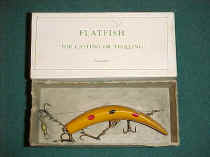 |
|
Hildebrandt Pearl Wobbler, Indiana Hildebrandt made many varieties of spoons and spinners, including thie genuine mother of peal lure with red glass beads. The green box features aneat graphic of Grandpa out fishing. Hildebrandt was based in Logansport, Ind. |
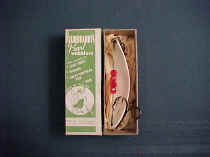 |
|
Hastings Weedless Frog, Chicago This soft rubber lure was patented and sold around 1895 in this wonderful picture box. The maker was Jas. T. Hastings Co. of Chicago. Sometime after 1905, W.J. Jamison bought the rights and made the lure into the 1920s. See the JAMISON chapter for three later boxed Hasting's frog lures. |
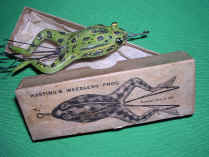 |
|
Hayes Feather Minnow, Indiana Hayes Bait Co. was an Indianapolis company that made a series of high-quality, rather large, flyrod lures. The Hayes Feather Minnow was almost three inches long. A tag inside the instructions in the box indicate Hildebrandt absorbed the company. This piece dates to the late 1920s. |
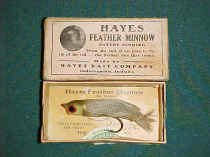 |
Hayes Go-Getter, Indianapolis Hayes Bait Co. also made this wonderful wooden plug featuring a single dressed hook that slid along a wire belly armature. The Hayes Go-Getyter lip, made of fragile celluloid, was easily broken, and the no-eyed lure is usually found in solid colors such as red/silver, red/white, all black, all white and even solid yellow. The Hayes Lures box is very tall. |
|
Hening & Baldwin, Benton Ridge, Ohio The Henning & Baldwin Live Minnow Fish Bait was marketed around 1909 and patented by Chester E. Hening on Sept. 11, 1911. Half the rights were assigned to Allen J. Baldwin. The lure is made of celluloid and pre-dates the Detroit Glass Minnow Tube by four years. Hening and Baldwin Live Minnow Fish Bait lures are rare. |
 |
|
Hinckley Fish Phantom, Newark, N.J. Livingston Hinckley created these historically important lures around 1895 and patented the Fish Phantom in 1897. The aluminum, revolving-head baits carry the 1897 patent date. The painted "Yellow Bird Fish Phantom" example in the picture includes original papers with instructions for fishing the "new" bait. This piece is over 100 years old! |
 |
Aluminum Fish Phantom, N.J. This is the more common (less rare) Hinckley Aluminum Fish Phantom. Note the unpainted finish. The bass size, unlike the baby size pictured above, has three treble hooks instead of one. The boxes date to 1900 and before and are hard to find in nice condition. This specimen surfaced in a tackle box stored for many decades in a Mississippi attic! |
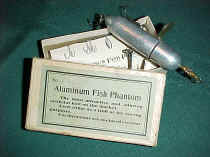 |
Silver Bird Fish Phantom, N.J. This is the large size "Silver Bird Fish Phantom," in a beautiful box that appears to have...a serial number! Like most other baits, it carries the 1897 patent date on one prop. Note the early box swivel line tie, which I think may have offered some inspiration to Shakespeare's Revolution baits. |
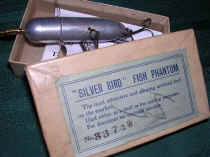 |
|
The milky-eyed Clyde Hoage Spoon-Fin Minnow is a spectacular 1930s Minnesota lure with a finely machined set of animated metal fins. The Hoage SpoonFin was usually finished in natural wood. They are rare, and SpoonFin boxes are almost unheard of. The Hoage Spoon Fin shown here is mint in the box and calls itself "The Perfect Minnow." |
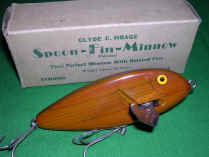 |
|
Homarth Tackle Co., Indianapolis Frequently misidentified as a Shur Strike Big Mouth Plunker, the glass-eyed Homarth Jigolo baits were made briefly during the 1930s. The glass eyes have a pinkish tinge that separates these unusual baits from mainstream makers. Homarth Bait Company was very short-lived. |
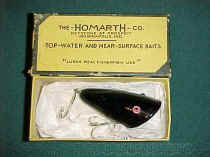 |
|
Hookzem Automatic Weedless Wobbler The Hookzem Automatic Weedless Wobbler was patented in 1919 by Henry L. Gottschalk of Chicago. The wooden bait has a trigger and spring-loaded hook release mechanism cocked by pushing the trigger toward the body near the line tie and pulling the cord. When a fish bites the hook shoots out the rear. Hookzem Bait Co. was located at 3343 N. Harding Ave. in Chicago. The Hookzem Automatic Weedless Wobbler is an exceptionally rare Chicago lure.
|
 |
|
|
 |
|
The Hootenanna, Montpelier, Ohio The Hootenanna is a simple, no-eyed wooden plug that came in endless colors and was made from the late 1930s to the 1950s. This older Hootenanna is in an attractive orange box with an unusual variation on the typical frogspot finish. |
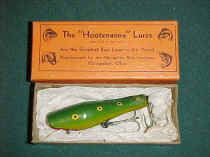 |
|
The Hoot-a-Nanny, Van Wert, Ohio This exquisite Hoot-a-Nanny box was no doubt an attention getter! We believe this was a spoof on the Hootenanna shown above, as Van Wert is just down the road from Montpelier. There is anecdotal evidence that a clever doctor from Van Wert had these cup-rigged, wooden baits made by Creek Chub Bait Company sometime in the mid 1930s. |
